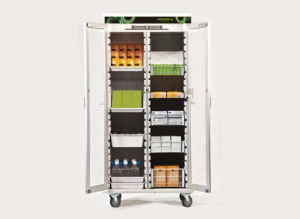RFID solutions in the medical industry often focus on things in the flow: checking surgical instruments into and out of the operating room; tracking wheelchairs, improving asset utilization; and even tracking patients carrying devices. The smart cabinet is another option for RFID to be used for intelligent storage in the medical field. These smart cabinets are embedded in the reader to track the inventory of installed tags (usually high-value items such as drugs) and are accessed by workers via secure credentials.

According to Technavio, the global RFID smartbox market will reach a compound annual growth rate of 14.03% in 2020. Some of these are driven by increased government regulations and increased pressure on high-value inventory management. Some smart cabinets are also participating in the larger market for smart medical products , which is expected to reach $57 billion by 2023.
Smart cabinets reduce labor costs for tracking and managing inventory, as well as reduce supply loss/shrinkage, reduce the risk of theft and save money. In addition to using these smart cabinets to manage drugs and surgical tools, other medical institutions such as clinical laboratories, research facilities, life sciences and biotechnology facilities also benefit from this type of automated inventory management.
There are some core benefits for healthcare providers:
Security - Smart cabinets typically use employee ID cards or code locks and anti-counterfeiting, so inventory can be burglar-proof and the organization records which employees have access to inventory.
Medicine Peptides and protein drugs are emerging. There are now 35 important therapeutics on the market, and the development of biotechnology and biopharmaceutical companies is becoming increasingly global. Biotechnology drug research focuses on the application of DNA recombinant technology to develop peptides, proteins, enzymes, hormones, vaccines, cell growth factors and monoclonal antibodies that can be used in clinical applications. According to Parexl's Pharmaceutical R&D Statistical Source Book, there are currently 723 biotech drugs under FDA review (including phase â…° to iii clinical and FDA evaluation), 700 drugs are in early stage (research and preclinical). More than 200 additional drugs are in the final stage of approval (Phase iii clinical and FDA evaluation). The basic dosage form of biotech drugs is lyophilized. Although the efficacy of conventional preparations has long been clinically proven, they need to be injected frequently for a long time due to their short half-life, which is difficult to accept from the perspective of psychological and economic burden on patients. To this end, scholars around the world mainly from two aspects to study and develop convenient and reasonable drug delivery approaches and new preparations: (1) embedment agent and sustained-release injection. â‘¡ Non-injectable dosage forms, such as respiratory inhalation, rectal administration, nasal administration, oral administration and transdermal administration, etc. Injectable preparations of sustained-release biotechnological drugs are new dosage forms with promising applications. Some of them, such as microsphere injections of luteinizing hormone releasing hormone (LHRH) analogues which can be sustained-release for 1 to 3 months, have been on the market. This paper focuses on this kind of preparations.Main types of peptides and protein drug sustained-release preparations The research and development of peptides and protein drug sustained-release preparations can be divided into two types, namely, embedment agent and microsphere injection, from the perspective of development process and dosage form. The shape of the implant is a hollow micro-fine rod, one end is closed, the other end is open, and the rod material is non-biodegradable polymer such as ptfe. The lumen was filled with a mixture of drugs and silica gel (silastic, polydimethylsiloxane). The implant is embedded under the skin, and the drug is released slowly through the opening of silica gel matrix. The American Physicians' Handbook (PDR) contains a product called Norplant? Levo-18 ethyl norethinnes, used in family planning. The preparation, each with a diameter of 2.4 mm and a length of 34 mm, is surgically implanted in the inner side of the patient's upper arm with 6 thin rods. The drug can be released in the body in zero-grade mode for up to 5 years, and then removed by surgery after release,1.1.2 Micro-osmotic pump embedding agent The United States Alza company in the 1970s developed an embedding agent shaped like a capsule, which is embedded in the skin or other parts. The body fluid can penetrate through the shell, dissolve the interlayer electrolytic layer, make the volume expansion of the interlayer pressure to the plastic inner cavity, and promote the drug solution from the opening of the fixed speed release. Many biomolecular drugs, such as insulin, heparin and nerve growth factor, have been reported as model drugs in vivo and in vitro. Implants have positive significance for the treatment of chronic patients who need long-term medication, but it has the following defects: â‘ must be surgically implanted. â‘¡ The skeleton material of the preparation is non-biodegradable polymer, which needs to be removed by surgery after release. â‘¢ The preparation has irritation and discomfort in local tissues. Evaluation methods for polypeptide protein drugs: 1. Liquid chromatography 2. Spectroscopic 3. Solvent-based versions are easy to use, but need to be kept at low temperatures (2-8 degrees Celsius).
medicine peptides high,Peptide injections,buy medicine peptides high,medicine peptides for bodybuilding,medicine peptides for hgh
Shaanxi YXchuang Biotechnology Co., Ltd , https://www.peptide-nootropic.com